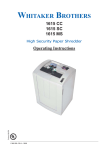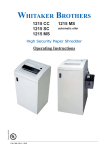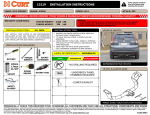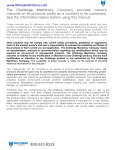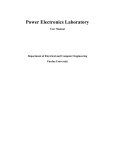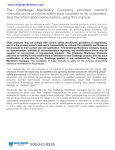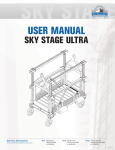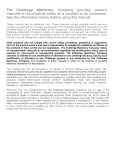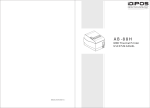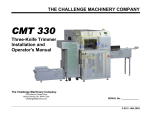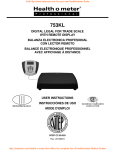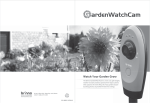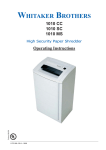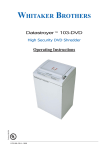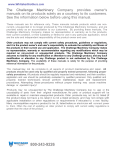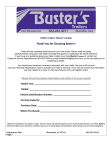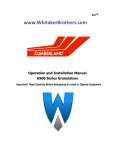Download User Manual
Transcript
www.WhitakerBrothers.com The Challenge Machinery Company provides owner's manuals on its products solely as a courtesy to its customers. See the information below before using this manual. These manuals are for reference only. These manuals include products which are noncurrent, unsupported or no longer produced by The Challenge Machinery Company, and are provided solely as an accomodation to our customers. By providing these manuals, The Challenge Machinery Company makes no representation or warranty as to the products, their current condition, or their suitability or fitness for use in any particular application, which are the sole and independent responsibility of the product owner and user. Older products may not comply with current safety procedures, guidelines or regulations, and it is the product owner's and user's responsibility to evaluate the suitability and fitness of the products in their current use and application. The Challenge Machinery Company makes no representation, warranty or recommendation regarding any modifications which may be required on non-current or unsupported products. The Challenge Machinery Company assumes no liability for any modification or alteration to any Challenge product, and any such modification or alteration to any Challenge product is not authorized by The Challenge Machinery Company. The availability of these manuals is solely for the purpose of providing reference information for the products. This manual may not be complete in all aspects of product maintenance and repair. All products should be used only by qualified and properly trained personnel, following proper safety procedures. All products should be regularly inspected and maintained, and their condition, application and use should be periodically evaluated by qualified personnel. Only qualified and properly trained technicians should perform maintenance, repair and replacement procedures. Attempting these procedures without proper training may cause machine damage or operator injury! Products may be unsupported by The Challenge Machinery Company due to age or the unavailability of parts from their original manufacturer. No parts or product support will be available to repair or maintain unsupported products. Older products may not be UL listed (if the product does not have a UL label it is not a listed product), and may not comply with applicable installation or other regulations or requirements if relocated to a new facility. Many municipalities require a product to be UL listed before an electrician will connect power to them. Often the cost of updating an older product to comply with current safety regulations is greater than the value of the product. INSTRUCTION AND PARTS MANUAL PADDY WAGON® PADDING PRESS Sold and Serviced by The Challenge Machinery Company 6125 Norton Center Drive Norton Shores, MI 49441-6081 USA ChallengeMachinery.com F.1722-B May 2011 1.0 Introduction 1.0 Introduction THIS MANUAL is designed to help you get the most from your Challenge equipment. Keep this manual in a safe, convenient place for quick reference by operators and service personnel. SAFETY ALERT! This symbol means CAUTION: Personal safety instructions! Pay special attention to the instructions in bold type. Personal injury may result if the precautions are not read and followed. READ THIS MANUAL BEFORE OPERATING! Follow precautions and instructions given and you should have years of trouble-free operation. If after reading the manual questions still remain, contact your Authorized Challenge Dealer. FOR PARTS AND SERVICE, contact the Authorized Challenge Dealer from whom you purchased your machine. Use the illustrations and parts lists at the back of this manual to identify the correct parts needed. Always give the SERIAL NUMBER and MODEL of your machine to insure the correct parts are sent as soon as possible. Be sure to fill out the warranty card accompanying your machine and return it DIRECTLY TO CHALLENGE. If you bought a used machine, it is important to have the following information on record at Challenge. Copy this page, fill in the information and send it care of The Challenge Service Department, 6125 Norton Center Drive • Norton Shores • MI 49441-6081. CHALLENGE MODEL ATTN SERIAL NUMBER COMPANY ADDRESS CITY PHONE DEALER NAME & CITY STATE/PROVINCE DATE INSTALLED ZIP * WARRANTY INFORMATION * It is very important that you read and understand the conditions outlined in the Warranty Information Sheet attached to the outside of the shipping container of your machine. The Warranty Information Sheet must be filled out completely and returned to THE CHALLENGE MACHINERY COMPANY in order for the warranty to be issued for this machine. Challenge® is a registered trademark of The Challenge Machinery Company • 6125 Norton Center Drive • Norton Shores, MI 49441-6081 Copyright© 1999-2011 by The Challenge Machinery Company. All rights reserved. Printed in the U.S.A 2 1.0 Introduction TABLE OF CONTENTS 1.0 Introduction ...................................................................................................................................... 2 2.0 Safety ............................................................................................................................................... 4 2.1 Precautions.................................................................................................................................. 4 3.0 Packing List...................................................................................................................................... 5 4.0 Specifications ................................................................................................................................... 6 5.0 Assembly Instructions ...................................................................................................................... 7 6.0 Operating Instructions .................................................................................................................... 13 7.0 Padding Tips .................................................................................................................................. 16 8.0 Drawings & Schematics ................................................................................................................. 17 8.1 Main Assembly – A-7400, Rev. Q ............................................................................................. 17 8.2 Main Assembly - A-7400, Rev. Q .............................................................................................. 18 3 2.0 Safety 2.0 Safety 2.1 Precautions • • • • • • • • • • 4 This machine is designed for one-person operation. Never operate the machine with more than one person. Safe use of this machine is the responsibility of the operator. Use good judgment and common sense when working with and around this machine. Read and understand all instructions thoroughly before using the machine. If questions remain, contact the dealer from which you purchased this machine. Failure to understand the operating instructions may result in personal injury. Only trained and authorized people should operate this machine. Do not alter safety guards or devices. They are for your protection. Severe personal injury may result. Observe all caution labels on this machine. CRUSH HAZARD - Keep hands from under paper clamp. KEEP THE FLOOR around the machine free of trim, debris, oil and grease. If the machine operates unusually, have it checked by a qualified service person or your Authorized Challenge Dealer. DO NOT STAND OR SIT ON THE MACHINE. 3.0 Packing List 3.0 Packing List Part No. 7402 A-7410 S-1886-1 S-1886 7411 S-1881-1 W-175 S-1883 A-7422-1 7426 7427 S-1729-8 H-5254-606 H-5247-5 H-7322-6 H-7321-8 H-5424-812 H-6424-6 H-6918-612 H-6961-1006 Description Table Assembly Stand Assembly End Caps, Top End Caps, Bottom Clamp Bar Caster Caster Wrench Handle Stop Rod Assembly Plastic Handle, Stop Rod Plated Spacer Plated Weldnut 3/8 x 3/4 Shoulder Bolt 5/16-18 Flex Lock Nut 3/8” Polished Washer ½” Plated Washer ½” x 1-1/2” Shoulder Bolt 3/8” Plated Hex Jam Nut 3/8” x 1-1/2” Soc. Hd. Stop Screw #10 x ¾” Flat Head Wood Screw Qty. 1 1 2 4 1 4 1 2 1 1 1 1 1 1 4 4 2 5 2 8 5 4.0 Specifications 4.0 Specifications Description Maximum Pile Width Maximum Pile Height Pile Depth Inch Units 23-1/2” 31” 3” to 17”+ Metric Units 60cm 79cm 8 to 43cm+ 30” x 30” 66” 100lbs. 120lbs. 76 x 76cm 168cm 45kg 55kg Fits easily through any standard 32” (81cm) door Dimensions Overall Height Net Weight (@) Shipping Weight (@) Challenge reserves the right to make changes to any product or specification without notice and without incurring responsibility to existing units. 6 5.0 Assembly Instructions 5.0 Assembly Instructions You will need the following tools to assemble your Paddy Wagon: • • • Phillips Screwdriver; 1/4” Hex Wrench and; 9/16” Open End Wrench. Immediately after unpacking, check off parts received against the packing list. Also, examine for any physical signs of damage incurred during shipment. The machine is inspected before and after packaging at our plant. The responsibility for filing a claim against the carrier for damages incurred during shipment rests with the receiver of the goods (FOB our factory). Figure 1 Figure 2 Two people should be used to take the base and top out of the box, Figure 2. They’re fairly heavy and awkward to handle for one person. If you don’t have two people, carefully cut the side out of the box and slide the pieces onto the floor. 7 5.0 Assembly Instructions Install the four casters into the bottom of the stand and tighten with the caster wrench supplied, Figure 3. Figure 3 Set the stand assembly upright, position the table assembly on the stand and while one person holds the table assembly, Figure 4. Figure 4 8 5.0 Assembly Instructions The other person should insert the pivot screw with a large washer between the stand and the table frames, Figure 5. Figure 5 Place a second large washer on the bolt, then secure one of the smaller washers with one of the hex nuts. Repeat on the opposite side, Figure 6. Figure 6 PINCH POINT. While assembling machine, care should be taken when mounting the table assembly onto the stand. Tilt the top section back and rest it on one of the filler boxes, Figure 7. Figure 7 9 5.0 Assembly Instructions Attach the Stop Rod to the bottom of the table with the shoulder bolt and flex lock nut. Use the two remaining 3/8” polished washers between the “U” and the brace if necessary to fill the gap, Figure 8. Shoulder Bolt Lock Nut Polished Washers Figure 8 Thread a hex nut onto the Stop Rod all the way to the top of the threads, Figure 9. Figure 9 Guide the bottom of the Stop Rod through the hole in the cross brace as you tilt the top of the padder to the upright position, Figure 10. Figure 10 10 5.0 Assembly Instructions Tilt the top back slightly and slide the spacer onto the Stop Rod. Then thread the plated weldnut onto the Tilt Rod. Adjust the hex nut above the spacer until it and the Tilt Rod will just slide freely into the hole in the cross brace. Next, tighten the weld nut against the tube. Be sure the weldnut is positioned side to side in the same direction as the center brace. If necessary, loosen the nut slightly, reposition the weld-nut and tighten the nut. (Figure 10 on page 10shows the weld-nut in the vertical-lock position.) Install the 3/8-16 nyloc nut against the weldnut. Figure 11 shows the Stopper in the Tilt position. Figure 11 To release the locking mechanism, lift up on the handle and tilt the top of padder back, Figure 12. Install a hex nut on each of the two leveling screws and insert through the frame under the table, Figure 13. Figure 12 Figure 13 11 5.0 Assembly Instructions Always lower top section slowly. Do not allow top section to free-fall into position. These are used as stops when the padder is in the vertical position. These should be adjusted to prevent uneven alignment of the padder. Tilt the padder to the vertical position and tighten the screws until they make contact and adjust them so they have equal pressure on each side. Then tighten the jam nuts. Insert the plastic End Caps onto the ends of the stand tubes. Note that two of the caps have a portion cut off. These are to be installed on the top of stand tubes to clear the pivot bolts, Figure 14. Figure 14 Attach the handles to both doors and the padder is ready for work. (Figure 15) Figure 15 12 6.0 Operating Instructions 6.0 Operating Instructions Always lower top section slowly. Do not allow top to free-fall into position. Lift the stop rod to tilt the machine forward, load the paper against the doors and the side pipe, tap any loose sheets flush to the doors, Figure 16. You can load the paper to within 5 inches of the top brace and the padder will still be steady. It’s designed to hold a full load but you must leave room at the top for the clamping bar and clamps. Figure 16 Place the clamping bar on top of the stack against the doors. If you’re padding 2 stacks, they should be of equal height so you get even clamping. If you’re just padding one side, hold the clamping bar in place until you can bring the clamp down to hold it. Tighten the stack side first and even it out with a turn on the other side when it needs it, Figure 17. Figure 17 To bring the Quick Release Clamp down to the Clamping Bar, just squeeze the lock and it will slide easily, Figure 18 on page 14. The clamp won’t come back up without unlocking. 13 6.0 Operating Instructions Figure 18 To release a tightened clamp, loosen the wing-screw to release some pressure, then push up on the lock. It will release and slide up easily. Tighten the wing-screws of the clamps until they are snug, Figure 19. Figure 19 Do not allow the Paddy Wagon to drop into position. Hold as shown in Figure 20 and ease into the upright position. Tilt the padder to the vertical position, as shown, Figure 20. Figure 20 14 6.0 Operating Instructions Do not stand on the machine to tilt the top section back into vertical position. Open the doors by lifting the handles and swinging them out, Figure 21. Figure 21 Paint the padding compound on the paper and spread it out thinly and evenly. Let it dry about 10 minutes or until it’s dry to the touch, Figure 22. Figure 22 Paint on the second coat and wait about 10 or 15 minutes or until its dry to the touch. Release the clamps; the pads can be cut apart with an ink or table knife. 15 7.0 Padding Tips 7.0 Padding Tips Loading The Paddy Wagon is on wheels to save you time while handling paper. You can load it directly from the cutter after a trim or you can take it out of the press, jog it, and load it directly into the padder there. Then roll it into the bindery department to be padded. Counting When you’re making a batch of pads of the same quantity ask the pressman to watch the counter on the press and slip a strip of paper in to mark the pads. You can then insert the chipboard as you jog and load the job. If that’s not possible, use a counter gauge. Count out one pad, measure it with the gauge and count the rest. Brushing With regular paper and regular compound, two thin coats will work better than one thick one. When you’re applying the compound, don’t try to put the second coat on until the first coat is dry or the brush will stick to the compound of the first coat and ruin it. To speed up the process, a hot air hair dryer can be used to decrease the drying time. Since you have to wait 10 or 15 minutes for the compound to dry, take advantage of the wheels on the PADDY WAGON and roll it into the corner while you work on something else. The Compound Regular padding compound tends to lose moisture the more it’s used so by the time you get half way through the bottle it’s pretty thick. To thin it out again, just add a little water and stir it up. Don’t add too much or the compound will be too thin and curl the edge of the paper. NCR When padding NCR or self-bonding papers that must absorb the compound, don’t use too much pressure on the clamps. The heavy pressure will squeeze the edge of the paper too tight and harden it so the compound can’t sink in. One coat usually works fine with this type of compound. Make sure the paper is good and dry before you release the pressure on the bar or the sets may not separate like they should. Separating the Pads To cut the pads apart, use an ink knife, paint scrapper, or kitchen knife. If the knife’s edge is too sharp or square, it will cut into the paper rather than separate the pads. A rounded blade seems to work the best. Try to time the drying times (you could use an egg timer with a bell if you’re inclined to forget things when you’re busy). It’ll make cutting the pads apart easier and neater. If you separate them too soon, the pads will tend to break apart. If you wait too long, the compound will harden and cut very roughly making the pads look sloppy. Wait about 15 minutes drying time on the second coat or when it’s dry to the touch. Cleaning The edge of the clamping bar and the table edge were designed to be easy to clean. Just use your padding knife to scrape the dried compound off the metal edges. If you want it really clean, finish up with a wet rag or sponge. 16 8.0 Drawings & Schematics 8.0 Drawings & Schematics 8.1 Main Assembly – A-7400, Rev. Q 17 8.0 Drawings & Schematics 8.2 Main Assembly - A-7400, Rev. Q 18




















